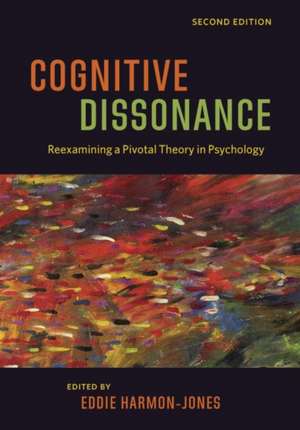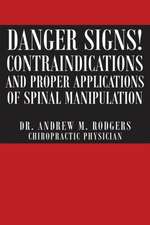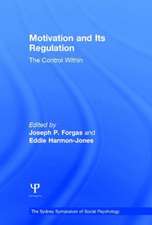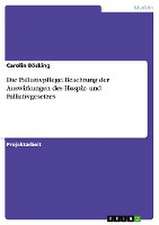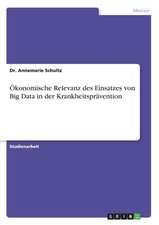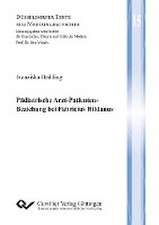Cognitive Dissonance – Reexamining a Pivotal Theory in Psychology
Autor Eddie Harmon–jonesen Limba Engleză Paperback – 11 mar 2019
2019 Outstanding Academic Title
This volume describes advances in the theory of cognitive dissonance, from its origination in 1954 to the present day.
This volume describes advances in the theory of cognitive dissonance, from its origination in 1954 to the present day.
Preț: 365.93 lei
Nou
Puncte Express: 549
Preț estimativ în valută:
70.03€ • 72.84$ • 57.81£
70.03€ • 72.84$ • 57.81£
Carte disponibilă
Livrare economică 25 martie-08 aprilie
Preluare comenzi: 021 569.72.76
Specificații
ISBN-13: 9781433830105
ISBN-10: 1433830108
Pagini: 304
Dimensiuni: 181 x 251 x 15 mm
Greutate: 0.57 kg
Ediția:00002
Editura: Wiley
ISBN-10: 1433830108
Pagini: 304
Dimensiuni: 181 x 251 x 15 mm
Greutate: 0.57 kg
Ediția:00002
Editura: Wiley
Cuprins
Contributors
Foreword to the First Edition
Foreword to the Second Edition
Preface
Chapter 1: An Introduction to Cognitive Dissonance Theory and an Overview of Current Perspectives on the Theory
Eddie Harmon-Jones and Judson Mills
Part I: Perspectives Employing the Original Version of the Theory
Chapter 2: Improving the 1957 Version of Dissonance Theory
Judson Mills
Chapter 3: A Radical Point of View on Dissonance Theory
Jean-Leon Beauvois and Robert-Vincent Joule
Chapter 4: Understanding the Motivation Underlying Dissonance Effects: The Action-Based Model
Eddie Harmon-Jones and Cindy Harmon-Jones
Chapter 5: What Is Cognitive Consistency, and Why Does It Matter?
Bertram Gawronski and Skylar M. Brannon
Chapter 6: Dissonance Now: How Accessible Discrepancies Moderate Distress and Diverse Defenses
Ian McGregor, Ian R. Newby-Clark, and Mark P. Zanna
Part II: The Role of the Self in Dissonance
Chapter 7: Dissonance, Hypocrisy, and the Self-Concept
Elliot Aronson
Chapter 8: Self-Affirmation Theory: An Update and Appraisal
Joshua Aronson, Geoffrey Cohen, and Paul R. Nail
Chapter 9: In Search of the Motivation for Dissonance Reduction: The Drive to Lessen Aversive Consequences
Joel Cooper
Part III: Mathematical Models, Neural Activations, and Affective Responses
Chapter 10: Modeling Cognitive Dissonance as a Parallel Constraint Satisfaction Network With Learning
Stephen J. Read and Brian M. Monroe
Chapter 11: Neural Basis of Cognitive Dissonance
Keise Izuma and Kou Murayama
Chapter 12: Moving Beyond Attitude Change in the Study of Dissonance-Related Processes: An Update on the Role of Discomfort
Patricia G. Devine, John M. Tauer, Kenneth E. Barron, Andrew J. Elliot, Kristen M. Vance, and Eddie Harmon-Jones
Appendix A: Social Communication and Cognition: A Very Preliminary and Highly Tentative Draft
Leon Festinger (1954)
Appendix B: Reflections on Cognitive Dissonance: 30 Years Later
Leon Festinger (1987)
Appendix C: Historical Note on Festinger’s Tests of Dissonance Theory
Judson Mills
Index
About the Editor
Foreword to the First Edition
Foreword to the Second Edition
Preface
Chapter 1: An Introduction to Cognitive Dissonance Theory and an Overview of Current Perspectives on the Theory
Eddie Harmon-Jones and Judson Mills
Part I: Perspectives Employing the Original Version of the Theory
Chapter 2: Improving the 1957 Version of Dissonance Theory
Judson Mills
Chapter 3: A Radical Point of View on Dissonance Theory
Jean-Leon Beauvois and Robert-Vincent Joule
Chapter 4: Understanding the Motivation Underlying Dissonance Effects: The Action-Based Model
Eddie Harmon-Jones and Cindy Harmon-Jones
Chapter 5: What Is Cognitive Consistency, and Why Does It Matter?
Bertram Gawronski and Skylar M. Brannon
Chapter 6: Dissonance Now: How Accessible Discrepancies Moderate Distress and Diverse Defenses
Ian McGregor, Ian R. Newby-Clark, and Mark P. Zanna
Part II: The Role of the Self in Dissonance
Chapter 7: Dissonance, Hypocrisy, and the Self-Concept
Elliot Aronson
Chapter 8: Self-Affirmation Theory: An Update and Appraisal
Joshua Aronson, Geoffrey Cohen, and Paul R. Nail
Chapter 9: In Search of the Motivation for Dissonance Reduction: The Drive to Lessen Aversive Consequences
Joel Cooper
Part III: Mathematical Models, Neural Activations, and Affective Responses
Chapter 10: Modeling Cognitive Dissonance as a Parallel Constraint Satisfaction Network With Learning
Stephen J. Read and Brian M. Monroe
Chapter 11: Neural Basis of Cognitive Dissonance
Keise Izuma and Kou Murayama
Chapter 12: Moving Beyond Attitude Change in the Study of Dissonance-Related Processes: An Update on the Role of Discomfort
Patricia G. Devine, John M. Tauer, Kenneth E. Barron, Andrew J. Elliot, Kristen M. Vance, and Eddie Harmon-Jones
Appendix A: Social Communication and Cognition: A Very Preliminary and Highly Tentative Draft
Leon Festinger (1954)
Appendix B: Reflections on Cognitive Dissonance: 30 Years Later
Leon Festinger (1987)
Appendix C: Historical Note on Festinger’s Tests of Dissonance Theory
Judson Mills
Index
About the Editor
Notă biografică
Descriere
Brings the study of cognitive dissonance into the 21st century. Contributors survey discoveries about the role dissonance plays in a variety of information processes, as well as connections between dissonance processes and other motivational processes. Mathematical and action-based models that summarize how dissonance works are also presented.
